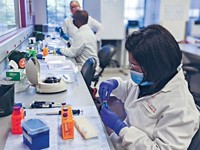Advertisement
Grab your lab coat. Let's get started
Welcome!
Welcome!
Create an account below to get 6 C&EN articles per month, receive newsletters and more - all free.
It seems this is your first time logging in online. Please enter the following information to continue.
As an ACS member you automatically get access to this site. All we need is few more details to create your reading experience.
Not you? Sign in with a different account.
Not you? Sign in with a different account.
ERROR 1
ERROR 1
ERROR 2
ERROR 2
ERROR 2
ERROR 2
ERROR 2
Password and Confirm password must match.
If you have an ACS member number, please enter it here so we can link this account to your membership. (optional)
ERROR 2
ACS values your privacy. By submitting your information, you are gaining access to C&EN and subscribing to our weekly newsletter. We use the information you provide to make your reading experience better, and we will never sell your data to third party members.


One of Nako Nakatsuka’s first lead-author papers emerged from a happy accident. During her doctoral program at the University of California, Los Angeles, Nakatsuka had inadvertently left a solution of the neurotransmitter serotonin out on her lab bench for around 2 weeks. She noticed it had turned a deep, luscious pink. Not only was it “perfectly beautiful,” she says, but it also turned out to be a key step in her research career. Now based at the Swiss Federal Institute of Technology, Lausanne (EPFL), Nakatsuka is using chemistry to develop biosensing tools for neuroscience applications.
Vitals
Current affiliation: Swiss Federal Institute of Technology, Lausanne (EPFL)
Age: 34
PhD alma mater: University of California, Los Angeles
Hometown: Tokyo
If I were an element, I’d be: “Carbon. It’s versatile and takes various forms depending on the external environment, which mirrors both the transformation I feel I’ve undergone in the journey of my academic career and my multidisciplinary and fluid approach to research, which has driven a lot of the creativity and out-of-the-box thinking.”
My favorite book is: “Give and Take, by Adam Grant. I’ve sometimes felt that if I’m too giving or ‘nice,’ people will not take me seriously, or [they’ll] underestimate me or take advantage of me. I was constantly battling this ‘I want to retain who I am even if I stay in academia.’ I don’t want to give away the key messages of the book, but it gave me the courage to continue being me, and it’s possible to be a giver and be successful.”
But back to that serotonin solution. Nakatsuka had done a lot of imaging work during her undergraduate research at Fordham University, using electron microscopy to visualize peptide structures that could be applied in tissue engineering. By the time she was partway through her PhD, supervised by Anne Andrews and Paul S. Weiss, she’d begun to miss the thrill of visualizing chemistry. “When I saw that pink color change, I thought, ‘Oh my gosh, this is the perfect opportunity to image something,’ ” Nakatsuka says.
Electron microscopy revealed that the pink color was caused by self-assembled serotonin-based nanoparticles, which could potentially be used to deliver drugs. A beautiful laboratory mishap had become “a real project that had some applications,” Nakatsuka says.
Nakatsuka is the kind of person who pays attention to beauty. She’s a painter, a drummer, a wine enthusiast, and an athlete who runs and cycles across the mountains and lakeshores of Switzerland. Born in Osaka, Japan, Nakatsuka has followed her curiosity all over the world. She attended a British school as a child in Tokyo, then spent her formative years in the US, completing her PhD in 2017. She stayed on for another 8 months as a postdoctoral fellow and then moved across the Atlantic for another postdoc at the Swiss Federal Institute of Technology (ETH), Zurich. In September 2020, she took a job as a senior scientist there, and in January this year, she secured a tenure-track position in EPFL’s Neuro X Institute in Geneva.
She’s now setting up her own lab there—the Laboratory of Chemical Nanotechnology, or CHEMINA. At the heart of Nakatsuka’s work are molecules called aptamers: short, single-stranded chains of nucleic acids that fold up into tiny 3D structures. Most change shape when they come into contact with a specific molecule, a property Nakatsuka is using to sense and monitor neurotransmitters inside the brain.
Nakatsuka integrates DNA aptamers with field-effect transistors so that when a target binds to an aptamer, the electric current flowing through the device changes. This setup might be used as a brain implant—for instance, to monitor dopamine levels in a person with Parkinson’s disease so doctors can adjust their treatment as needed. “What I think has been really exciting, especially coming to Neuro X at EPFL, is that it’s really people who are interested in translational technologies,” Nakatsuka says. “How do we actually make an impact for patients?”
Because Nakatsuka is both scientifically and artistically inclined, she briefly considered attending art school. Eventually, though, she married her interests by illustrating a children’s book called A is for Atom: ABCs for Aspiring Chemists. The biggest challenge of her career, she says, has been the need to uproot herself every few years. “Leaving behind the people you love and care for—that I’ve now had to do on three continents,” Nakatsuka says.
Advertisement
Still, Nakatsuka finds ways to create community wherever she roams. At ETH Zurich, she started a wine club, mentored students, and contributed to the university’s diversity initiatives. Now she organizes welcome events for new hires at EPFL, including group jogging outings and cocktail parties.
Janos Vörös, deputy head of the Institute for Biomedical Engineering at ETH Zurich and Nakatsuka’s former mentor, calls Nakatsuka a natural leader. “She has high expectations of herself and, at the same time, a very supporting management style for people who are working with her,” Vörös says. “She leads by example rather than by pressure.”
Diagnostics
Nako Nakatsuka
This neurotechnologist integrates aptamers and transistors to monitor brain chemistry
by Rowan Walrath
May 17, 2024
| A version of this story appeared in
Volume 102, Issue 15

Credit: EPFL/Tania Di Paola and Adrian Alberola/C&EN | Nako Nakatsuka is a tenure-track assistant professor in EPFL's Laboratory of Chemical Nanotechnology.
Vitals
Current affiliation: Swiss Federal Institute of Technology, Lausanne (EPFL)
Age: 34
PhD alma mater: University of California, Los Angeles
Hometown: Tokyo
If I were an element, I’d be: “Carbon. It’s versatile and takes various forms depending on the external environment, which mirrors both the transformation I feel I’ve undergone in the journey of my academic career and my multidisciplinary and fluid approach to research, which has driven a lot of the creativity and out-of-the-box thinking.”
My favorite book is: “Give and Take, by Adam Grant. I’ve sometimes felt that if I’m too giving or ‘nice,’ people will not take me seriously, or [they’ll] underestimate me or take advantage of me. I was constantly battling this ‘I want to retain who I am even if I stay in academia.’ I don’t want to give away the key messages of the book, but it gave me the courage to continue being me, and it’s possible to be a giver and be successful.”
One of Nako Nakatsuka’s first lead-author papers emerged from a happy accident. During her doctoral program at the University of California, Los Angeles, Nakatsuka had inadvertently left a solution of the neurotransmitter serotonin out on her lab bench for around 2 weeks. She noticed it had turned a deep, luscious pink. Not only was it “perfectly beautiful,” she says, but it also turned out to be a key step in her research career. Now based at the Swiss Federal Institute of Technology, Lausanne (EPFL), Nakatsuka is using chemistry to develop biosensing tools for neuroscience applications.
But back to that serotonin solution. Nakatsuka had done a lot of imaging work during her undergraduate research at Fordham University, using electron microscopy to visualize peptide structures that could be applied in tissue engineering. By the time she was partway through her PhD, supervised by Anne Andrews and Paul S. Weiss, she’d begun to miss the thrill of visualizing chemistry. “When I saw that pink color change, I thought, ‘Oh my gosh, this is the perfect opportunity to image something,’ ” Nakatsuka says.
Electron microscopy revealed that the pink color was caused by self-assembled serotonin-based nanoparticles, which could potentially be used to deliver drugs. A beautiful laboratory mishap had become “a real project that had some applications,” Nakatsuka says.
Nakatsuka is the kind of person who pays attention to beauty. She’s a painter, a drummer, a wine enthusiast, and an athlete who runs and cycles across the mountains and lakeshores of Switzerland. Born in Osaka, Japan, Nakatsuka has followed her curiosity all over the world. She attended a British school as a child in Tokyo, then spent her formative years in the US, completing her PhD in 2017. She stayed on for another 8 months as a postdoctoral fellow and then moved across the Atlantic for another postdoc at the Swiss Federal Institute of Technology (ETH), Zurich. In September 2020, she took a job as a senior scientist there, and in January this year, she secured a tenure-track position in EPFL’s Neuro X Institute in Geneva.
She’s now setting up her own lab there—the Laboratory of Chemical Nanotechnology, or CHEMINA. At the heart of Nakatsuka’s work are molecules called aptamers: short, single-stranded chains of nucleic acids that fold up into tiny 3D structures. Most change shape when they come into contact with a specific molecule, a property Nakatsuka is using to sense and monitor neurotransmitters inside the brain.
Nakatsuka integrates DNA aptamers with field-effect transistors so that when a target binds to an aptamer, the electric current flowing through the device changes. This setup might be used as a brain implant—for instance, to monitor dopamine levels in a person with Parkinson’s disease so doctors can adjust their treatment as needed. “What I think has been really exciting, especially coming to Neuro X at EPFL, is that it’s really people who are interested in translational technologies,” Nakatsuka says. “How do we actually make an impact for patients?”
Because Nakatsuka is both scientifically and artistically inclined, she briefly considered attending art school. Eventually, though, she married her interests by illustrating a children’s book called A is for Atom: ABCs for Aspiring Chemists. The biggest challenge of her career, she says, has been the need to uproot herself every few years. “Leaving behind the people you love and care for—that I’ve now had to do on three continents,” Nakatsuka says.
Still, Nakatsuka finds ways to create community wherever she roams. At ETH Zurich, she started a wine club, mentored students, and contributed to the university’s diversity initiatives. Now she organizes welcome events for new hires at EPFL, including group jogging outings and cocktail parties.
Janos Vörös, deputy head of the Institute for Biomedical Engineering at ETH Zurich and Nakatsuka’s former mentor, calls Nakatsuka a natural leader. “She has high expectations of herself and, at the same time, a very supporting management style for people who are working with her,” Vörös says. “She leads by example rather than by pressure.”







Join the conversation
Contact the reporter
Submit a Letter to the Editor for publication
Engage with us on Twitter